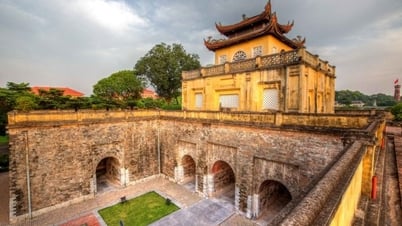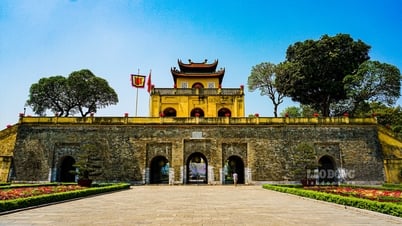Similarly, Son Tay town will be reorganized from the current 13 wards and communes into 3 wards, including one named Son Tay. Retaining the names Ha Dong and Son Tay not only inherits the history of the place name but also shows respect for the two lands that were the names of provinces in the past.

Son Tay today is an ancient land, originally part of Phong Chau - the legendary capital of 18 Hung Kings. During the period of Chinese domination, this land was part of Giao Chi district, later separated into Tan Hung district, then renamed Tan Xuong. During the Dinh, Tien Le and Ly dynasties, the name Phong Chau was restored.
Under the Tran Dynasty, Phong Chau was divided into three regions and the land of Son Tay today was located in the Quoc Oai region. After defeating the Ming invaders, in 1428, King Le Thai To divided Dai Viet into five regions, of which Son Tay belonged to the Tay region.
In 1469, under the reign of King Le Thanh Tong - famous for his extensive administrative reforms - the Son Tay Thua Tuyen administrative unit (equivalent to a province) was established, including 24 districts belonging to 6 prefectures, including parts of present-day Vinh Phuc and Phu Tho. At this time, Son Tay town belonged to Quoc Oai prefecture.
The name "Son Tay" was born at this time, 556 years ago, with the simple meaning: "Mountains to the west" of Thang Long citadel. In 1509, the Le dynasty changed the name of this administrative unit from Son Tay Thua Tuyen to Son Tay Xu. In folklore, this land is also known as Xu Doai.
Although the name Son Tay has remained the same throughout the ages, the administrative boundaries and capital of this land have changed a lot. In 1822, King Minh Mang moved the Son Tay town to the territory of Mai Trai and Thuan Nghe communes in Minh Nghia district (later renamed Tung Thien), which is the central area of Son Tay town today.
Due to its important strategic location in terms of military , in the same year, King Minh Mang built Son Tay citadel, also known by the people as Doai citadel.
In 1831, during a large-scale administrative reform, King Minh Mang established Hanoi province and changed Son Tay town to Son Tay province. At the same time, Tu Liem district was transferred to Hanoi province, and Tam Nong district was cut off to Hung Hoa province (now Phu Tho).
In 1892, the French colonial government redivided the administrative boundaries of Bac Ky, causing the area of Son Tay province to shrink, leaving only two prefectures: Quoc Oai and Quang Oai, with four districts: Thach That, Phuc Tho, Tung Thien and Bat Bat. On April 21, 1965, Son Tay province was merged with Ha Dong province, forming Ha Tay province. The name Son Tay province officially no longer exists, however, Son Tay town is still retained.
In 2007, Son Tay town was upgraded to a city. However, in 2008, implementing the National Assembly's Resolution on adjusting the administrative boundaries of Hanoi capital, Ha Tay province was merged into Hanoi. Therefore, Son Tay city became a town again, directly under Hanoi city.
The name “Ha Dong” appeared quite late in the process of forming administrative units in Bac Ky. On October 1, 1888, King Dong Khanh was forced to issue an edict to cede to France the entire Tho Xuong district and a small part of Vinh Thuan district of Hanoi province to establish the concession city of Hanoi. Therefore, the administrative headquarters of Hanoi province could no longer be located within the boundaries of this new city. On January 26, 1896, Governor-General of Indochina Armand Rousseau issued a decree to move the provincial headquarters to Cau Do village, located along the Nhue River.
By the early 20th century, with the intention of expanding control and reorganizing the governing apparatus of Indochina, France decided to choose Hanoi - the concession city - as the capital of the Indochina Federation. Having a province with the same name as the capital was inappropriate in the colonial administrative system. Therefore, on May 3, 1902, Governor-General of Indochina Paul Doumer issued a decree to change the name of Hanoi province to Cau Do province.
However, because “Cầu Đơ” is only a colloquial name for a small village, not commensurate with the size and location of a province bordering the federal capital, there were many objections and suggestions to change the name. Perhaps Governor General J. Paul Beau was also not satisfied with this name, so on December 6, 1904, he signed a decree to change the name of Cầu Đơ province to Hà Đông province.
The name Ha Dong was proposed by the Third Prize Winner Vu Pham Ham - who was then the provincial education director - and was approved. Later, Ha Dong town was recognized as a city under Ha Tay province. When Ha Tay province merged into Hanoi on August 1, 2008, Ha Dong city was converted into a district under the capital.
Although the administrative units have changed - from province to town, then from town to ward - the names Son Tay and Ha Dong, along with their long history and unique cultural values, have not been lost. They are still clearly present in today's life and will continue to spread in the future.
Source: https://hanoimoi.vn/ten-goi-ha-dong-son-tay-qua-nhung-bien-thien-lich-su-704106.html






























![[Photo] Nghe An: Provincial Road 543D seriously eroded due to floods](https://vphoto.vietnam.vn/thumb/1200x675/vietnam/resource/IMAGE/2025/8/5/5759d3837c26428799f6d929fa274493)


































































Comment (0)